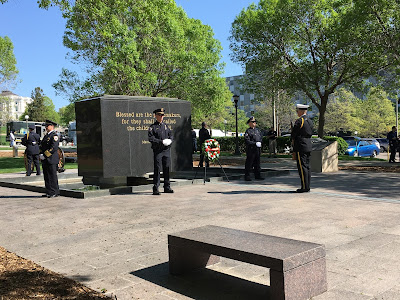I remember being in a home following up on an investigation and looking out the front window seeing the large snowflakes coming down. I said to the home owner I was working with, "I didn't think it was supposed to start this soon." He said, "I thought it was supposed to start as rain." It was about noon on Thursday, Oct. 31, 1991.

As I drove to work that morning, I heard for the first time that snow was predicted to start in the late afternoon. As I finished up at the house and headed back to my police car, it was snowing
hard. I was wearing my summer uniform shoes that had minimal tread—I remember I was slipping as I made my way down the driveway and hung on the squad car as I skidded to a stop. There had been no indication of snow when I'd arrived at the house 30 minutes earlier.
Once in the car I immediately remembered the car had its "summer shoes" on as well. (The department normally put the snow tires on the cars around November 15th.) It was alarmingly slippery as I made my way back to the station. This was before the internet, and weather information came to us from broadcast radio and television, plus we got some information via the state data terminal. The radio weather forecast was suddenly changing and more snow, strong winds, and a blizzard were predicted.
At the station, plans were made to get the afternoon and night shifts in early, and to press the unmarked vehicles with four-wheel drive into service for patrol work. We also borrowed some four-wheel drive vehicles from the fire department. The already busy public works shop would get started on the police snow tires shortly.
The snow-related calls for service started coming in; it was like someone flipped a switch and we were instantly overrun with calls. We prioritized them based on the level of personal injury, beginning with crashes with injuries and medical calls, then crashes without injuries. Reports of cars sliding off the road would have to wait for a while. I had changed to my winter boots, but my car would not get snow tires for a few more hours yet as the city was concentrating on the cars that would be working later in the afternoon and evening. The public works supervisor said he would free up a snow plow if we needed one to get to a call.
I was sent on a medical call to assist a young man who had severed some fingers while trying to unclog a running snow blower. An assistant fire chief had arrived first in his all-wheel drive SUV and was handling the patient care. A family member located the fingers and we preserved them. We kept the ambulance a block away as the hill going down to the house was extremely slippery and we didn't think the ambulance would be able to get back up the hill. We got the boy and his dad to the fire chief's pickup and he took them up the hill to the ambulance. We ended up hand pushing the ambulance as it worked its way to a plowed road. I heard a few days later they were not able to reattach the fingers.
I was only held over a few hours, as the second and third shifts were in early. By 7 p.m., calls for services were slowing down. It appeared most people had left work early and were home and hunkered down. Going into the night shifts, things were extremely quiet and stayed quiet for the next two days. When I worked on Friday and Saturday, it was almost eerie, as there were no calls, and no traffic. People were staying put. We had a few emergencies but nothing that was life threatening.
We worked closely with our public works crews, who periodically needed a car moved. We tried not to tow the cars if possible, as it was obvious that no one intentionally parked their cars in the middle of the residential street. Often plows would get close, and we would call the registered owner who then showed up and, with a little shoveling, could back out onto a portion of the street that had been plowed.
Before it was all done we had received 28.4 inches of snow. Friday and Saturday brought high winds and a rapid drop in temperature. The wet snow had adhered to the warm pavement and then frozen. The roads would be difficult for the next week as the cold weather did not allow the chemical melter to melt the packed snow. It reminded me of driving on a bad washboard gravel road.
Lessons Learned
Prepare for winter early. It's Minnesota, it's going to snow so prepare early. The new date to change snow tires for the police department was moved to the third week of October. Our winter snow removal ordinance was changed to be effective November 1. It was previously November 15.
Work as a team. The entire city staff worked together and went the extra mile to help other departments. We knew each other and valued each other.
Be agile. As the calls for service rapidly increased, and the ability to respond became more difficult, we adapted. We used different vehicles, and the chief even authorized any footwear that worked until the storm was over. We adapted again once the crisis was over and we could take extra time to assist our citizens and maybe save them a tow bill.
And for the next week, the conversation everywhere was all about "storm stories."
Up next: Highlights from the IACP Annual Conference.
Stay safe,
Rob
























